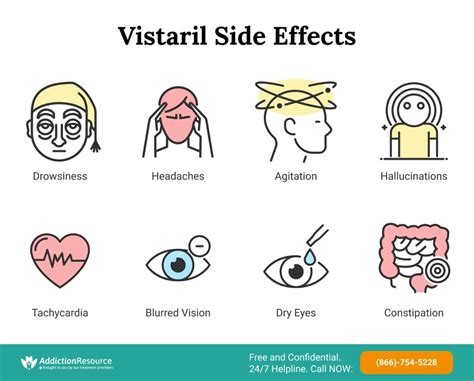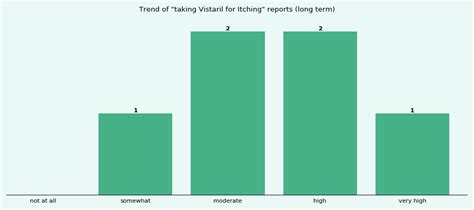Intro
Discover Vistaril side effects, including drowsiness, dizziness, and withdrawal symptoms. Learn about hydroxyzines common and rare effects, interactions, and warnings to ensure safe usage and minimize adverse reactions.
The importance of understanding medication side effects cannot be overstated, particularly when it comes to prescription drugs like Vistaril. Hydroxyzine, commonly known by its brand name Vistaril, is an antihistamine used to treat various conditions, including anxiety, insomnia, and itching caused by allergies. While Vistaril can provide relief for these conditions, it's crucial for patients to be aware of the potential side effects associated with its use. This knowledge enables individuals to make informed decisions about their health and to recognize when they might need to consult their healthcare provider.
Vistaril works by affecting the brain to reduce anxiety and itching, and it can also induce drowsiness, making it useful for treating insomnia. However, like all medications, it comes with a range of possible side effects, some of which can be mild and temporary, while others may be more severe and require medical attention. Understanding these side effects is key to ensuring that the benefits of taking Vistaril outweigh the risks for each individual. Moreover, being aware of the potential side effects can help patients and their healthcare providers monitor the medication's impact and adjust treatment plans as necessary.
The use of Vistaril, like any other medication, should be approached with caution, especially in certain populations such as the elderly, children, and individuals with pre-existing medical conditions. These groups may be more susceptible to the side effects of Vistaril, and their healthcare providers may need to closely monitor them. Furthermore, the potential for interactions with other medications or substances, such as alcohol, should be considered, as these can exacerbate side effects or reduce the efficacy of Vistaril. As patients navigate the complexities of their health and treatment options, comprehensive information about Vistaril side effects is indispensable.
Common Side Effects of Vistaril

The common side effects of Vistaril include drowsiness, dry mouth, and dizziness. These effects are usually mild and may diminish as the body adjusts to the medication. However, they can impact daily activities, especially those that require alertness and concentration. Other common side effects may include headache, nausea, and constipation. It's essential for patients to discuss these side effects with their healthcare provider, especially if they find them bothersome or if they interfere with daily life.
Less Common but Serious Side Effects
Less common but potentially serious side effects of Vistaril can include confusion, especially in the elderly, and difficulty urinating. These effects warrant immediate medical attention, as they can be signs of more severe issues. Additionally, Vistaril can cause changes in heart rhythm, which, although rare, can be life-threatening. Monitoring for these less common side effects is crucial, especially in vulnerable populations.Long-Term Use and Dependence

Long-term use of Vistaril can lead to dependence, a condition where the body becomes accustomed to the drug, requiring increased doses to achieve the same effect. This can be particularly problematic for individuals taking Vistaril for extended periods, as it may lead to a vicious cycle of increasing doses and dependency. Furthermore, stopping Vistaril abruptly after long-term use can result in withdrawal symptoms, which can be uncomfortable and, in some cases, severe. Therefore, it's crucial for patients to follow their healthcare provider's guidance on dosage and duration of treatment.
Special Considerations
Certain populations, such as pregnant women, breastfeeding mothers, and individuals with liver or kidney disease, require special consideration when taking Vistaril. For pregnant women, the potential risks of Vistaril to the fetus must be weighed against the benefits of treatment. Breastfeeding mothers should also exercise caution, as Vistaril can pass into breast milk and affect the baby. Individuals with liver or kidney disease may need dose adjustments, as these conditions can affect how the body processes Vistaril.Interactions with Other Medications

Vistaril can interact with a variety of other medications, including other antihistamines, sedatives, and certain antidepressants. These interactions can lead to increased side effects, such as excessive drowsiness, or can reduce the effectiveness of one or both medications. It's essential for patients to inform their healthcare provider about all medications they are taking, including over-the-counter drugs and supplements, to minimize the risk of adverse interactions.
Managing Side Effects
Managing the side effects of Vistaril often involves a combination of lifestyle adjustments and, in some cases, changes to the treatment plan. For example, patients experiencing dry mouth can try sucking on sugar-free candy or ice chips, while those with constipation may benefit from increased fluid intake and dietary changes. In cases where side effects are severe or persistent, healthcare providers may consider altering the dosage or switching to a different medication.Conclusion and Future Directions

In conclusion, while Vistaril can be an effective treatment for various conditions, it's crucial for patients to be aware of the potential side effects. By understanding these effects and taking steps to manage them, individuals can maximize the benefits of Vistaril while minimizing its risks. As medical research continues to evolve, it's likely that new insights into the side effects of Vistaril and strategies for their management will emerge, further enhancing patient care and outcomes.
Final Thoughts
As patients navigate the complexities of Vistaril treatment, open communication with healthcare providers is key. By sharing concerns, reporting side effects, and adhering to treatment plans, individuals can ensure that their use of Vistaril is both safe and effective. Whether used for anxiety, insomnia, or itching, Vistaril has the potential to significantly improve quality of life, provided that its side effects are carefully managed.What are the most common side effects of Vistaril?
+The most common side effects of Vistaril include drowsiness, dry mouth, and dizziness. These effects are usually mild and temporary.
Can Vistaril be used during pregnancy?
+Vistaril should be used with caution during pregnancy. The potential risks to the fetus must be weighed against the benefits of treatment, and patients should consult their healthcare provider.
How can I manage the side effects of Vistaril?
+Managing the side effects of Vistaril often involves lifestyle adjustments, such as staying hydrated to combat dry mouth, and, in some cases, changes to the treatment plan. Patients should discuss their side effects with their healthcare provider to determine the best course of action.
We invite readers to share their experiences with Vistaril, ask questions, or seek advice on managing its side effects. Your engagement can help others better understand the benefits and risks associated with this medication. Whether you're considering Vistaril as a treatment option or currently taking it, your input is valuable in fostering a community of informed and supportive individuals. Please feel free to comment below or share this article with others who might benefit from the information provided.
